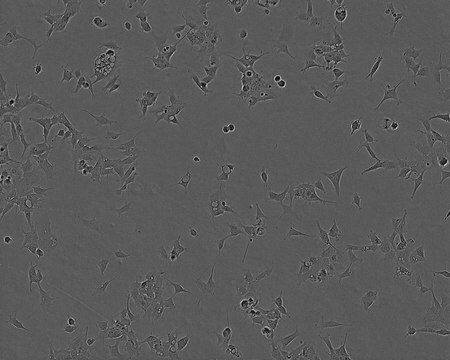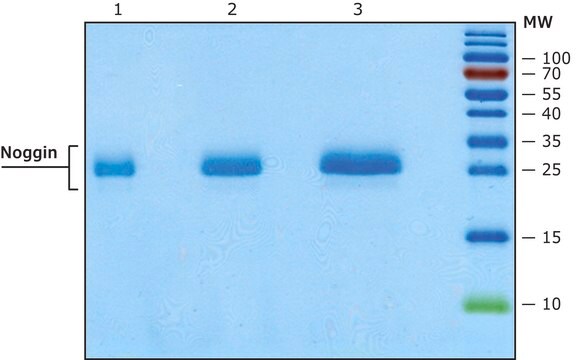推荐产品
product name
R-Spondin1 expressing 293T Cell Line, The R-Spondin1-Expressing 293T cell line produces RSPO1, a critical protein used to establish 3D organoid cultures from stomach, small intestine, colon, pancreas, and liver sources.
生物源
human
品質等級
運輸包裝
ambient
一般說明
3D organoid culture systems are increasingly employed as powerful tools for the study of human diseases. Organoids are thought to better represent the tissue-specific niche microenvironment. R-spondin-1 (RSPO1) is one of the most extensively used niche factors for culturing 3D organoids. The first published report of an organoid culture system able to promote long-term survival and multilineage differentiation of intestinal stem cells (ISCs) employed mouse Rspo1 as one of the critical factors . Since then, R-Spondin1 has been used to establish organoid cultures from the stomach, small intestine, colon, pancreas and liver from both mouse and human sources .
RSPO1 is an intestinal growth factor that works as a potent activator of the Wnt/beta-catenin signaling pathway by binding to leucine-rich repeat–containing G protein–coupled receptors (LGRs), which are expressed in tissue stem cells. RSPO1 also binds to the transmembrane E3 ubiquitin ligases RNF43 and ZNRF3 and triggers their internalization, thereby potentiating Wnt signaling.
The 293T cell line is stably transfected to express mouse R-spondin1 protein tagged with N-terminus HA epitope tag and C-terminus mouse IgG2α Fc region. R-Spondin1 expressing 293T cell line can be used to produce either purified Rspo1 or Rspo1 conditioned media. The FC region and HA tags enable ease of purification and characterization. Cell line is not the published cell line from the Kuo lab, but rather a related cell line developed in the same lab using the reference protocol.
The 293T cell line is stably transfected to express mouse R-spondin1 protein tagged with N-terminus HA epitope tag and C-terminus mouse IgG2α Fc region. R-Spondin1 expressing 293T cell line can be used to produce either purified Rspo1 or Rspo1 conditioned media. The FC region and HA tags enable ease of purification and characterization. Cell line is not the published cell line from the Kuo lab, but rather a related cell line developed in the same lab using the reference protocol.
細胞系描述
Epithelial Cells
應用
Research Category
Cell Culture
Cell Culture
This product is intended for sale and sold solely for internal non-commercial research use per the terms of the “Restricted Use Agreement” as detailed in the product documentation. For information regarding any other uses, please contact licensing@emdmillipore.com.
品質
• Each vial contains ≥1X10⁶ viable cells.
• Cells are tested negative for HPV-16, HPV-18, Hepatitis A, B, C, Herpesvirus type 6, 7, 8 and HIV-1 & 2 viruses by PCR.
• Cells are negative for mycoplasma contamination.
• Each lot of cells is genotyped by STR analysis to verify the unique identity of the cell line.
• Cells are tested negative for HPV-16, HPV-18, Hepatitis A, B, C, Herpesvirus type 6, 7, 8 and HIV-1 & 2 viruses by PCR.
• Cells are negative for mycoplasma contamination.
• Each lot of cells is genotyped by STR analysis to verify the unique identity of the cell line.
儲存和穩定性
Store in liquid nitrogen. The cells can be cultured for at least 10 passages after initial thawing without significantly affecting the cell marker expression and functionality.
免責聲明
RESEARCH USE ONLY. This product is regulated in France when intended to be used for scientific purposes, including for import and export activities (Article L 1211-1 paragraph 2 of the Public Health Code). The purchaser (i.e. enduser) is required to obtain an import authorization from the France Ministry of Research referred in the Article L1245-5-1 II. of Public Health Code. By ordering this product, you are confirming that you have obtained the proper import authorization.
儲存類別代碼
10 - Combustible liquids
水污染物質分類(WGK)
WGK 1
閃點(°F)
Not applicable
閃點(°C)
Not applicable
其他客户在看
Toshiro Sato et al.
Cell, 161(7), 1700-1700 (2015-06-20)
Tissue stem cells require unique niche microenvironments. In the presence of specific combinations of niche factors, mouse and human epithelial tissues from stomach, small intestine, colon, pancreas duct, and liver bile duct efficiently form stereotypic organoids. The platform of epitheloid
Toshiro Sato et al.
Science (New York, N.Y.), 340(6137), 1190-1194 (2013-06-08)
Recent examples have highlighted how stem cells have the capability to initiate morphogenesis in vitro; that is, to generate complex structures in culture that closely parallel their in vivo counterparts. Lgr5, the receptor for the Wnt-agonistic R-spondins, marks stem cells
Christian Moya Gamboa et al.
Cells, 10(12) (2021-12-25)
The liver is among the principal organs for glucose homeostasis and metabolism. Studies of liver metabolism are limited by the inability to expand primary hepatocytes in vitro while maintaining their metabolic functions. Human hepatic three-dimensional (3D) organoids have been established
Akifumi Ootani et al.
Nature medicine, 15(6), 701-706 (2009-04-29)
The in vitro analysis of intestinal epithelium has been hampered by a lack of suitable culture systems. Here we describe robust long-term methodology for small and large intestinal culture, incorporating an air-liquid interface and underlying stromal elements. These cultures showed
Yoshimasa Saito et al.
STAR protocols, 1(1), 100009-100009 (2020-10-29)
This protocol is a procedure for establishment and culture of cancer and non-cancer organoids using tissues from biliary tract carcinoma (BTC) patients. These BTC organoids can be used for various biological analyses and drug screening. One challenge in establishing and
商品
rganoid culture products to generate tissue and stem cell derived 3D brain, intestinal, gut, lung and cancer tumor organoid models.
我们的科学家团队拥有各种研究领域经验,包括生命科学、材料科学、化学合成、色谱、分析及许多其他领域.
联系技术服务部门









